Strength training is the best way to gain muscle mass quickly. In addition to the aesthetic aspect, the arms are constantly used, whether in everyday life or for other sports activities. There is therefore a double interest in training, you still have to know how to do it!
If you’ve been looking for exercises and methods to build your biceps without equipment , you’ve come to the right place. I also started weight training at home, without any equipment. With experience, I can share my feedback with you so that you can progress faster while avoiding certain mistakes.
In addition to showing you a sure way to have bigger arms, you will know if your goals are achievable and in how long. To help you with your program, a list of biceps exercises to do at home is waiting for you at the end of the article.
Summary:
Is training without equipment enough to have big biceps?
Are you going to have results without going to the gym, thanks in part to the body weight? To give a clear answer, yes, you will have something to do to develop your biceps without equipment .
They are easy to tire and hypertrophy with little or no material, unlike other large muscle groups, such as the pecs.
However, the choice of exercises and holds is limited. It is therefore in your best interest to structure your bodybuilding program , so as not to stagnate quickly.
The ideal is still to get the bare minimum in order to vary the exercises, the grips and the loads for a few euros. The investment is well worth the effort:
- Elastics
- A dumbbell and a few kilos of cast iron (minimum, 2 discs of 5kg and 4 discs of 2kg).
How long does it take to develop your biceps without equipment?
Another frequent question, how long does it take to have your first results? Truth be told, it depends, it doesn’t.
The speed of progression depends on a lot of things. Not everyone starts from the same point and everyone has their own goals. In addition to your age, lifestyle and genetics, it is above all the regularity and intensity of your weight training sessions that will allow you to reach your goals.
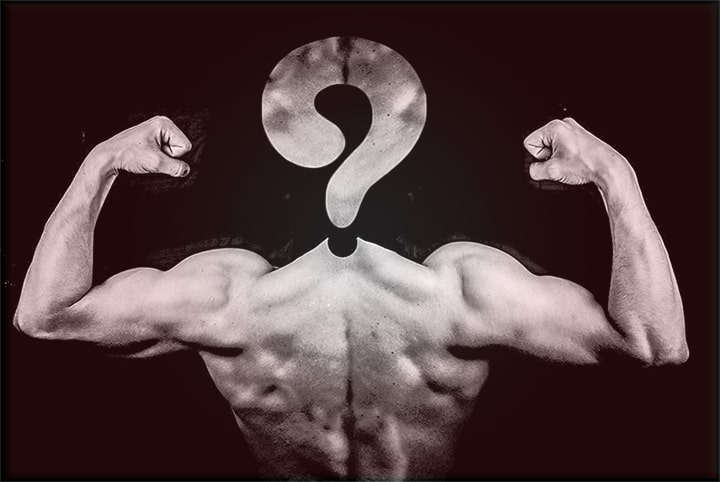
With perseverance, you will be able to notice a visual difference after 3 to 4 months of rigorous practice, even with little equipment.
How many repetitions, sets, exercises and weight training can you do to work your biceps?
You will understand, it is above all the quality of your sessions and your discipline that will allow you to increase your performance and your results, but beware! Remember that one of the keys to progress in bodybuilding is recovery.
If you don’t stick to this baseline, you risk ending up over-training. The risks?
- Nervous exhaustion (loss of strength)
- Biceps pathology, tendonitis…
- Poor muscle recovery
- Hormonal disruption
So this is the opposite of what we are looking for … I wrote an article to find out if weight training every day is a good or a bad idea.
In fact, there is no silver bullet. However, I can give you some tips on how to have a consistent basis for your biceps program .
| Questions | Answers | Notes |
|---|---|---|
| How many repetitions? | 6 to 15 | If the goal is to gain muscle mass |
| How many series? | ~ 4 by exercise | Stop when losing strength or getting bored |
| How many exercises? | 1 à 3 | Vary the angles and exercises from one session to another |
| How many sessions? | 3 per week | 1 day of rest minimum between each session |
It will differ from person to person. Over time and with experience, you can determine what works best for you. Note that sooner or later you will have to increase the number of sets and / or exercises to hypertrophy your muscles , in this case, your biceps.
Push-ups and dips, unnecessary exercises to build your biceps
While chatting or searching the net, I’m amazed at how many people think push-ups and dips are helpful for working the biceps. It is important to remember the function of the biceps and the other arm muscles to understand why this is totally wrong.
- Biceps: allows you to flex the forearm (pulling movement)
- Triceps: to stretch the arm or bring it back to the body (pushing movement)
- Forearms: Lower, raise, open or shake the hand. Certain muscles also allow the forearm to be raised or lowered.
Thus, it is enough just to put a tension, a constraint during the solicitation of the target muscle, to develop and strengthen it.
In the case of dips and push-ups, it’s when pushing, when you stretch out your arms, that the movement is difficult. As a result, it is not the biceps that are used, but rather the triceps (as well as the shoulders and pectorals).
Let’s rectify the mistake: push-ups and dips don’t make for bigger biceps, but rather more big arms , thanks to the development of the triceps.
The secret to having big arms: biceps, triceps and forearms
It is always good to remember that a good physique is a harmonious physique . You need to take the time to work all of your muscles and not a specific muscle group to have satisfactory results.
When it comes to the upper body, I find that a lot of practitioners are working hard on the biceps to get bigger arms. However, it is especially the triceps that give the most mass. Maybe your problem is there?
Lack of forearms can also be a problem. If you lack forearm mass compared to biceps and triceps, the result will be much less impressive. If Stallone looks massive, it’s mainly thanks to his over-developed forearms.
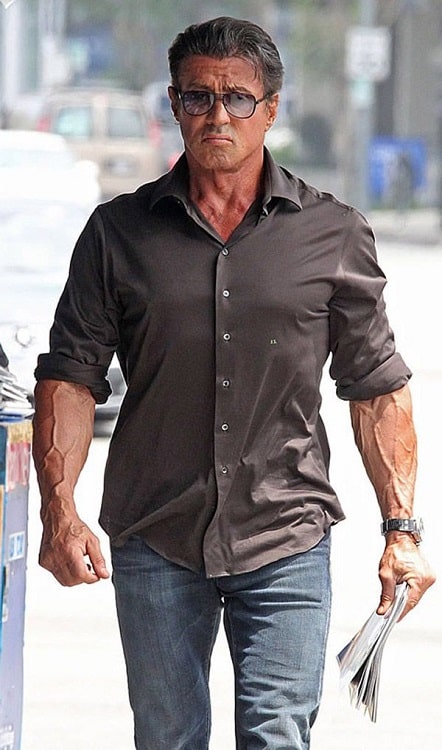
Bottom Line: If the initial goal is to have big arms, I strongly encourage you to develop all of the arm muscles . It is above all consistency and muscle definition that should be sought, not size.
Supine traction, the only polyarticular exercise to work the biceps without equipment
Contrary to popular belief, the horizontal bar pull-up (or chest pull-up) is the only polyarticular exercise for the biceps.
The advantages of this exercise are multiple:
- It does not require any hardware
- The body weight is more than sufficient at first
- The exercise exploits the tension / length relationship of the biceps, so you are stronger
Of course, as this is a polyarticular exercise , other muscles will also be engaged, especially those of the back. Note that hanging from a bar also improves your grip and therefore strengthen certain muscles of the forearm .
To get the most out of the biceps work in this exercise, it is important to perform it with a supine grip, i.e. with the palms facing you, then lean a little forward back when pulling to limit the work of the back muscles.

Another important point, the range of motion . Be careful during the descent not to fully stretch the arms, the biceps are vulnerable with a supine grip, this can lead to muscle tearing. In fact, it is one of the most common injuries in weight training. The goal is to build muscle , not to injure yourself for a “cleaner” movement.
Strategies for improving strength in pull-ups
Often times when you are just starting out, it is difficult to chain reps to pull-ups. If you really have trouble doing pull-ups, you can find alternatives to quickly progress on this exercise. Here are some options:
- Pure negative: perform the descent only
- Elastic: to relieve a little weight, just hang it on the bar and let a foot or a knee rest on it
- Reverse Rowing: Do the exercise with a bar close to the floor. The body is almost horizontal with the feet on the ground, so there is less weight to pull.
You can also consult this article if you want to increase your strength, in order to progress during your sessions.
Isolation exercises for the biceps to do at home
After reaching a certain point, isolation exercises will be useful for rebalancing certain portions of the biceps. To understand the importance of a “balanced” biceps, it is necessary to talk about anatomy. Here are the arm muscles to develop primarily with the biceps:
- Biceps: short and long head
- Brachialis (anterior)
- Brachioradial (formerly long supinator)
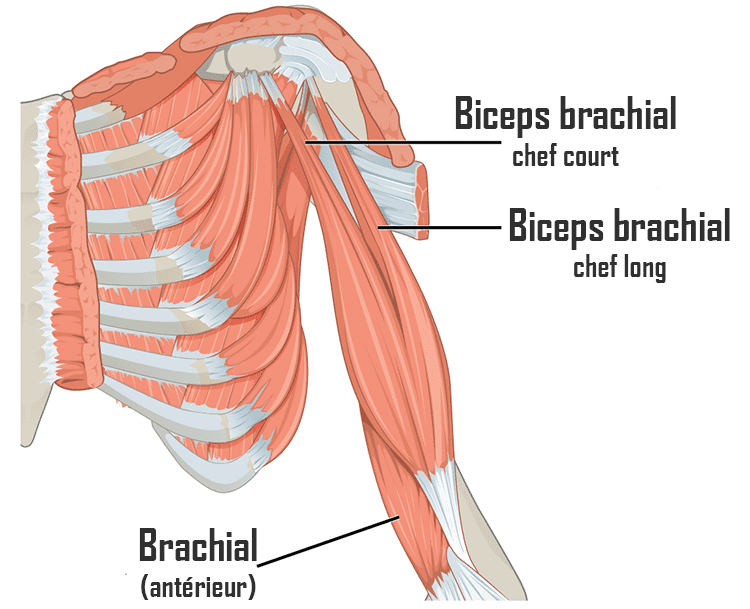
Over time, you will have to modify your training program to correct the imbalances. The most frequent cases are as follows:
- The long chef is often late compared to the short chef.
- The anterior brachialis is often less developed than the other portions of the biceps.
- The brachioradialis is also often overlooked, which can be crippling and problematic if you have short biceps.
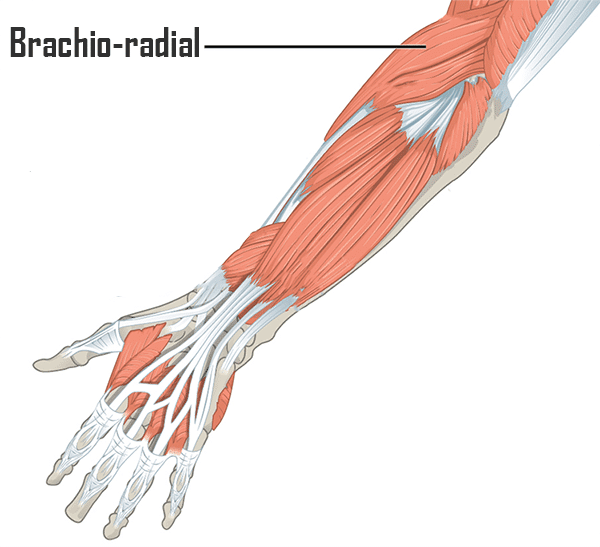
To remedy these problems, three variations of dumbbell curl are particularly effective. The exercises listed below can be done with a single dumbbell , rubber bands, or both combined to modulate tension.
Exercise 1: Supination curl for the long and short head of the biceps
Undoubtedly one of the most popular exercises, the supination grip curl (palms of the hands towards you) allows you to recruit mainly the long and short head. At least, this is usually where you feel the most work on your biceps.
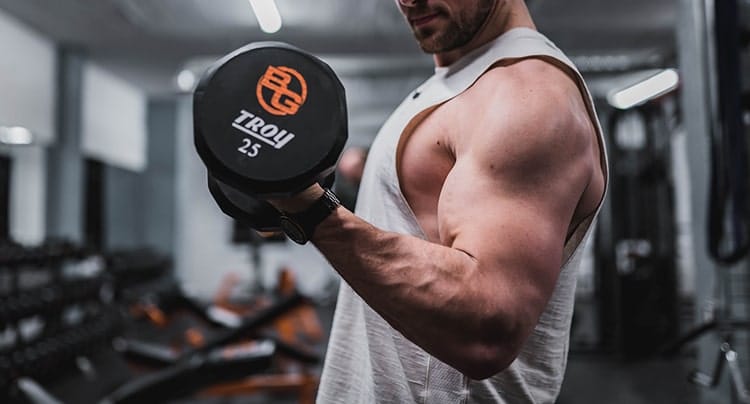
The unilateral exercise , that is to say one arm at a time, is preferable to have more strength during the series. As the work isn’t overly exhausting, you can do one arm while the other is resting to save time.
While the exercise sounds straightforward, you should still pay attention to the range of motion to avoid injury. To do this, you must be careful not to stretch your arm too much during the descent, as during the pull-ups. Aches in the ends of the biceps is not a good sign and usually means that you have stretched your arms too far.
Another detail that may seem insignificant: the placement of the elbow. If the elbow is at the back of the bust, you will mainly work on the long head of the biceps . In contrast, the leader runs is better insulated when the elbow is in front of the bust. It’s up to you to judge which leader is behind the other.
Exercise 2: Target the brachialis with the hammer curl
Usually underdeveloped, the brachialis can eventually grow as large as the biceps. You can easily tell how weak the brachii muscle is when you contract the biceps (lack of relief). It should also be mentioned that with this intake you further strengthen the muscles in your forearm.
The execution of the movement remains the same as in supination, except that the grip is neutral (thumbs up). However, this variant is still less dangerous, so you can reach out without fear of injuring yourself.
With a neutral grip, your arm is in a strong position, you will be able to put much heavier on this exercise.
Exercise 3: Catch the weakness of a short bicep with the pronation curl
The potential for muscle development is directly correlated with the size of your muscle, on top of that a long muscle will always be more impressive than a short muscle.
The advantage of having a short bicep is that you have a very noticeable peak when you contract it, but when released it looks thinner.
You can easily determine the length of your muscle. To do this, just contract it to see if the gap between the bicep and forearm is too large.
Unfortunately, you can’t lengthen your muscles, but all is not lost for your biceps. It is always possible to make up for this gap by developing the brachioradialis .
To emphasize the work of the brachioradial when performing curls, just perform the hand over pronation exercise , that is to say facing the ground.
The exercise may seem uncomfortable for the first few sessions. Do not hesitate to play with the rotation of your hand to have a working angle adapted to your body type, you get used to it quickly.
As with the hammer curl, it is possible to extend the arm at the end of the movement without risk of injury. Moreover, you can gradually switch to a neutral grip over the course of your series, when fatigue begins to be felt, to scratch a few repetitions.
There you go, all you have to do is build your workout program with this workout list. You really have to pay attention to your strengths and weaknesses to work effectively and have results that meet your expectations.
Are you interested in training programs for the biceps that you can do without equipment?


About the author